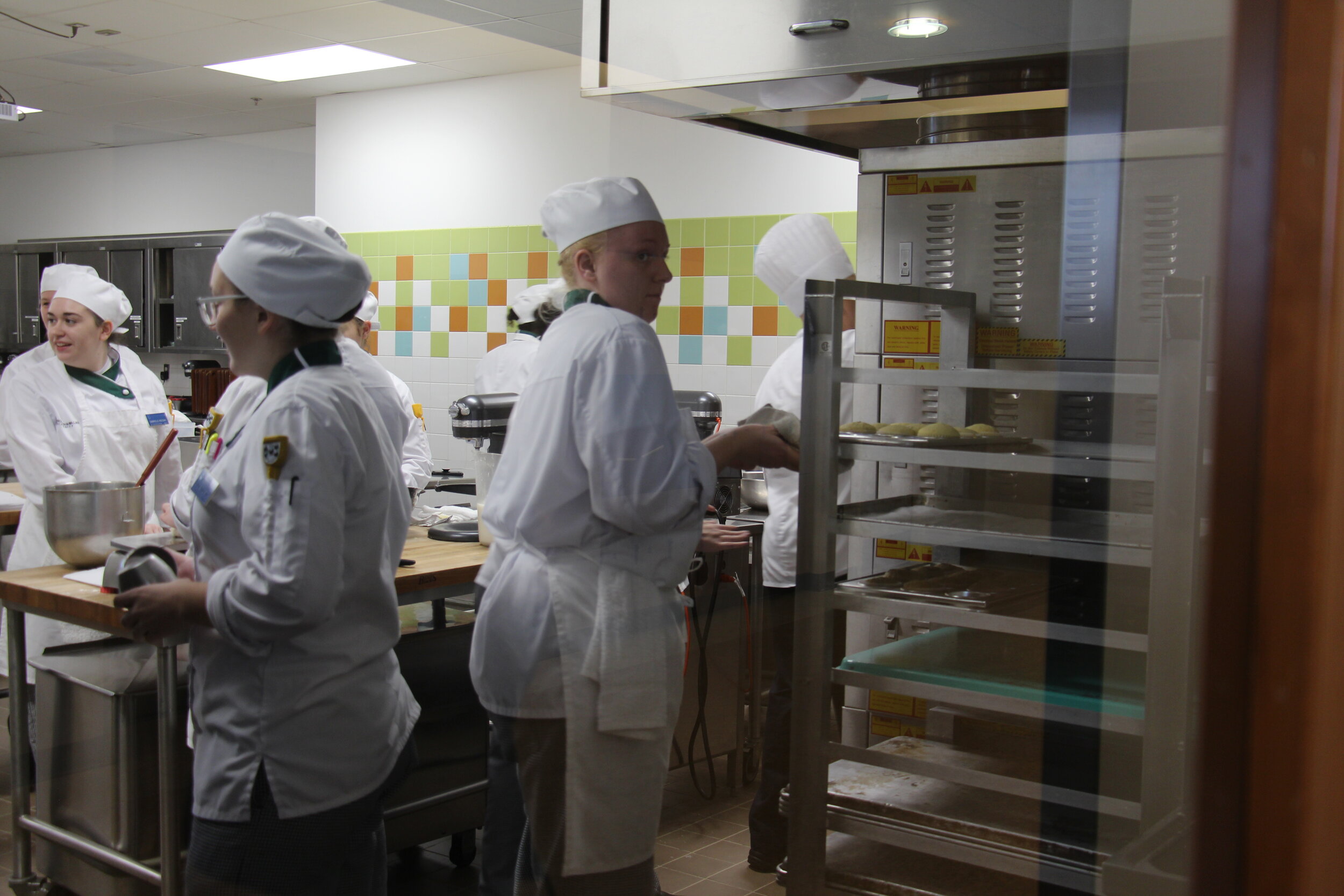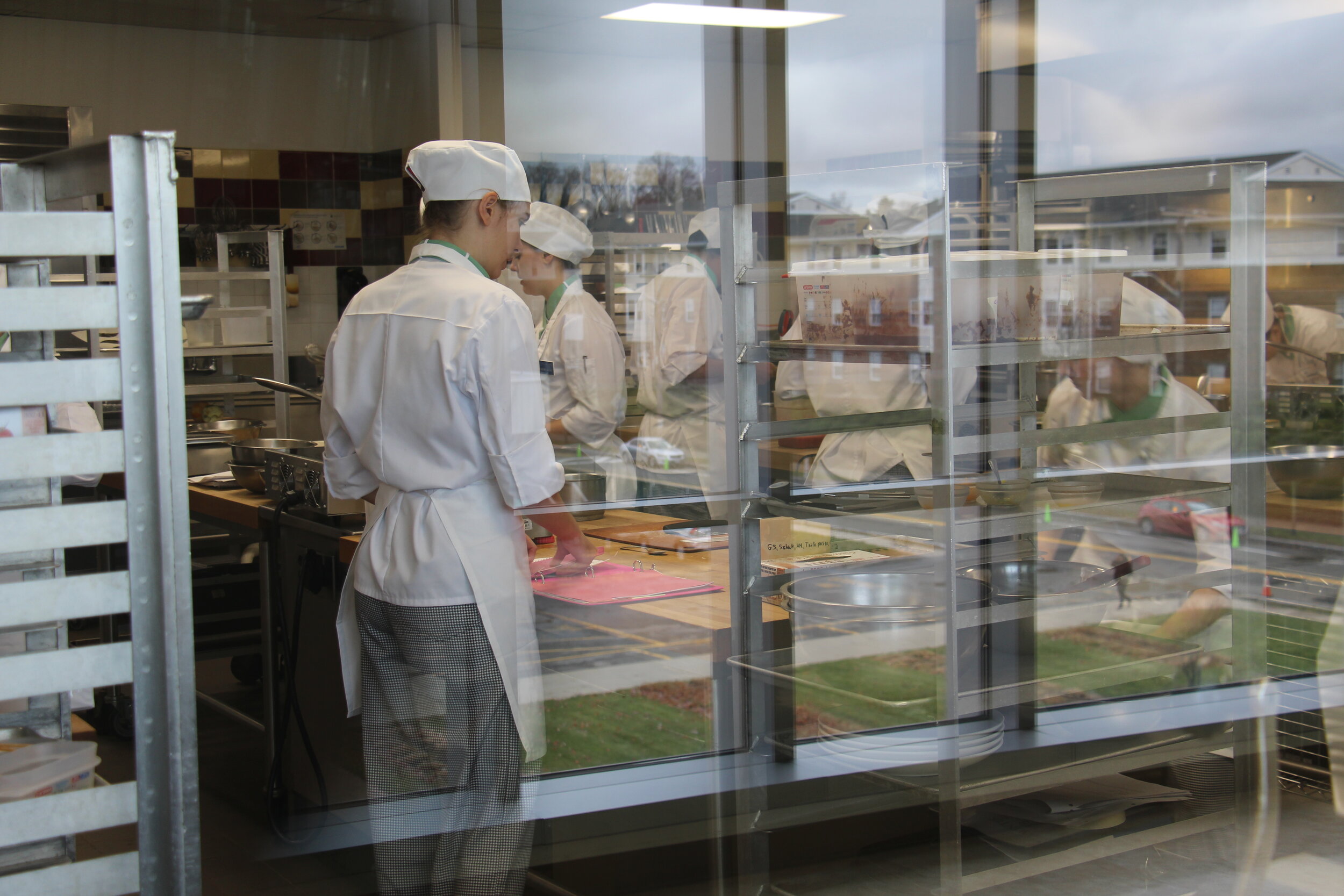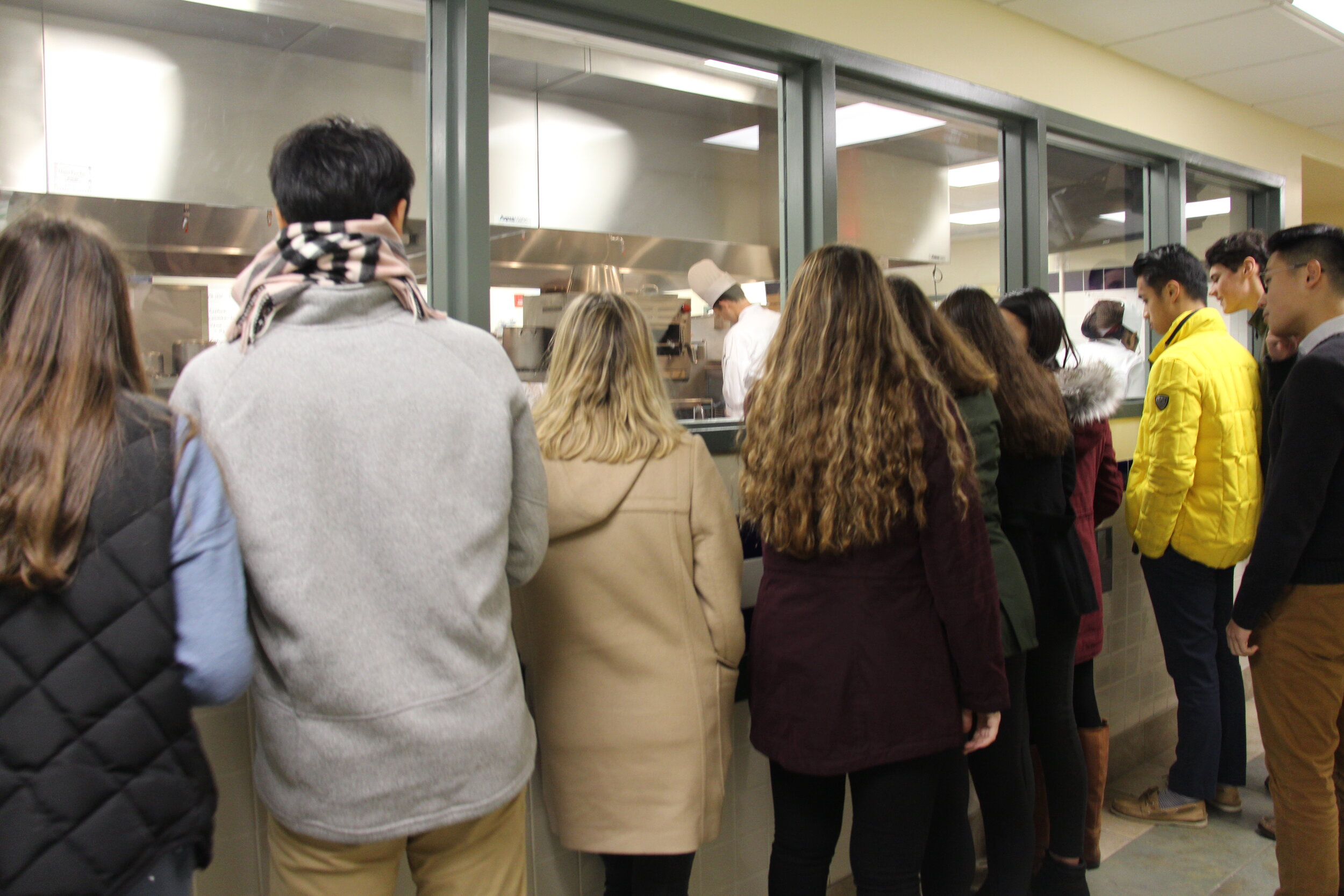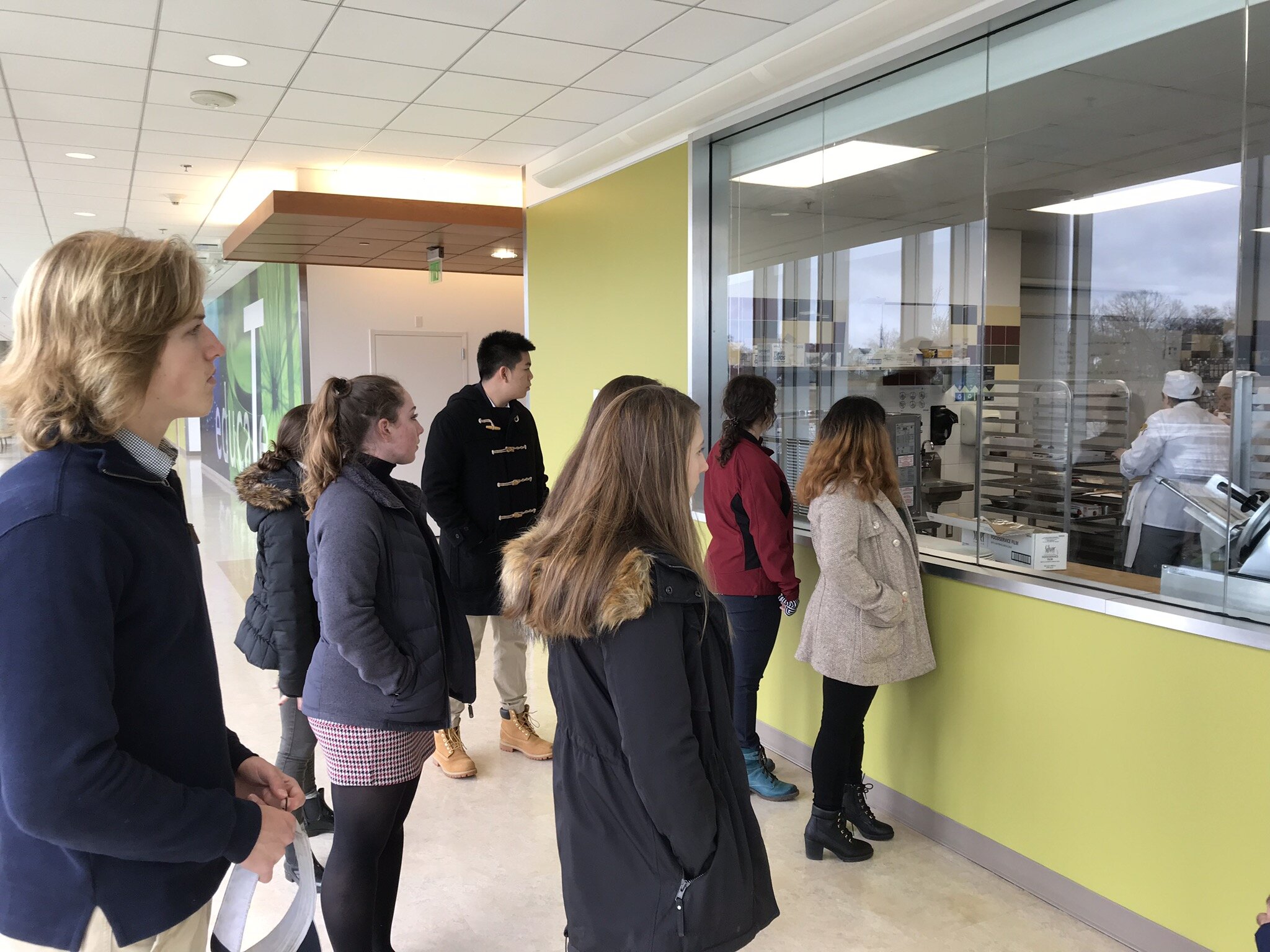A Chef’s Education: Our visit to Johnson and Wales University
The beginning of the long Winter Term included a college visit, though not the kind our seniors have been making now for months. One cannot talk about food and cooking without knowing where it all starts, hence our tour of this campus highlighting the Culinary Arts.
We all had a great time learning about the details of culinary school. I was excited to visit Johnson and Wales in particular because many of the chefs at the restaurant I work at in the summer are currently attending or have graduated from culinary school there.
For as much of a food fanatic as I am, I wouldn’t consider myself to be the best chef out there. Visiting a school where they start their students from scratch (no pun intended) and begin by teaching them the fundamentals of the Culinary Arts is inspiring and makes me feel much better that the best meal I can make is mac ‘n cheese. Students like myself, with little cooking skills, could attend school there and become a chef without any prior knowledge. My favorite part of the day was watching the different classes learn recipes in the main culinary learning building. I was very impressed with the complex as a whole, but especially how real they made the classrooms and other learning spaces feel. Rooms such as the bar setting for mixing class and the large dining spaces overlooking the water made it feel as though we were at a hotel. This provides the culinary students with real life experience to enhance their learning outside the classroom.
In addition to learning how to cook and bake, I appreciated the fact that students also have to learn management/ public skills and how to run the front of the house as well as the kitchen. This makes for a well-rounded chef who can see the bigger picture of the restaurant, not just the dish they’re making. The delicious pizza was a perfect way to wrap up the day and try food made by the students themselves. –Justine DelMastro ‘19
Recently the Culinary Club traveled to Johnson and Wales University to tour the campus and witness various culinary classes that take place within the school. Ever since I was younger, Food Network was a channel that was always on my television. The competitive cooking battles, along with the at home cooking shows, were very therapeutic to me. When we recently traveled to Johnson and Wales, I got to witness the beginning that most of the chefs on Food Network had experienced. Not only did a delicious aroma fill the hallways and cause my mouth to water from the start of the tour to the end, but also I was amazed at the work that the students were able to produce. I felt as if I was on the Food Network channel, watching as the chefs prepared their meals. It was insane to see how food can be transformed into art and how delicate and beautiful it can be made. While touring one of the floors within the culinary building at the university, we came across a display of sculptures crafted completely from sugar. When watching the Food Network channel, specifically Cake Wars, their sugar creations seem surreal and impossible to construct. Therefore, when I saw what college students were able to produce, I was completely astonished.
Usually when the average high school student imagines college they picture lecture halls filled with hundreds of students. However, Johnson and Wales showed another side of education. The hands-on activities, especially the room where students were practicing their bartending skills, made learning seem fun. After this experience, a part of me wanted to change my major.—Maddie Burt ‘19
A trip to Johnson and Wales University was the perfect way to return from Thanksgiving break and jump into Winter Term. The school is filled with attractive and modern facilities and has “labs” for all types of food processes and prep. Some of the most eye-catching labs to look in on were mixology, protein carving, and a class where students had to mold sugar and chocolate into intricate and creative designs. One of the most notable things about the school is that no kitchen experienced is required to get into the school – all chefs start from square one. Then they even help chefs get footing in the culinary world by aiding them in landing competitive internships. After touring around the campus and ending in their gym students can use as they please, it was time for the long-awaited lunch. Every new hall in the tour had a new smell ranging from cooking steak to baked bread, so this food was definitely needed. The group went to a restaurant called “Red Sauce” where students of the school cook all the food. It served Italian-based cuisine. The Caprese sandwich, filled with some of the most light and fresh tomatoes and mozzarella slices was top notch. Overall, it’s a university that seems to have a tight-knit and supportive community that can inspire any chef to reach above and beyond their potential. —Abby Gibbons ‘19
Being on the Johnson and Wales campus seemed like a magical world filled with beautiful cakes and every ingredient known to man. A lot of the items they made were filled with whimsy–like the Alice and Wonderland Cake that was on display as well as beautiful swirling sculptures decorated with flowers that are entirely made out of chocolate or sugar. That’s what I like most about cooking and baking, even though it is an exact science, there is still room to be creative, which Johnson and Wales clearly shows their students.
There were a lot of specific things that really piqued my interest. Starting out were the amazing labs, some filled with marble tables for working with chocolate, others filled with mixers for baking. It was like I was transported to all the best cooking and baking shows. I wish we could do what they are doing for my biology labs! Then there was this beautiful dining room that had an even more beautiful view of the water, where students could sign up for free for a seat at a 3-course meal made by students in their dining services class. I simply couldn’t believe it! Lastly, there was a really interesting mixology course that we got to watch where the students use water that matches the color and viscosity of certain alcoholic beverages in order to make drinks. The class was in such a vibrant room that had decorations spanning the walls and music playing in order to emulate a real bar. This all added up to a dream-like experience that made for the perfect first day back after Thanksgiving. —Sarah Costa ’19
Seeing the lively campus from afar, and the remarkable buildings which comprised the greater part of this culinary institution, was only a precursor to the treat we were in for. A learning center filled with potential and a healthy atmosphere greeted us, and it became apparent that this school has recently made great strides in adding on to its already large campus. Buildings that look not 10 years old dot the landscape, and state-of-the-art cooking equipment call the classrooms and eateries home. Learning concepts and opportunities seen nowhere else but Johnson and Wales University appear prevalent around every corner. This school encompasses traditional college ideals while maintaining its stronghold in the Culinary Arts, providing endless opportunity for those who attend, and it will be interesting to see its progression in the coming years. –Dan Teravainen ‘19
Over the past few months, college has become one of the most talked about subjects for Portsmouth Abbey seniors, and on Tuesday, November 27th, the Portsmouth Abbey Culinary Arts club embarked on what appeared at first glance to be something all too familiar: a college tour. However, the trip to Johnson and Wales University in Providence soon proved to be an experience unlike any college I had visited previously and was in fact a tour of one of the foremost culinary education programs in the country. Although I had no expectations about what a culinary school should look like, I was nevertheless astounded by the rigor and intensity of the classes we observed.
Our tour’s first stop was the state-of-the-art Cuisinart Center for Culinary Excellence, an enormous facility that houses most of the culinary program. Instead of classrooms, the building was filled with enormous glass-walled kitchens, which are referred to as “labs.” A lab-based course runs for nine days, during which students delve deeply into a single topic, culminating in a feast at the end. These classes are often very specialized, and on our tour we saw a butchering class, a bartending class, and a display of chocolate artwork fit for a gallery. Although considered as only one course, the lab classes run for six hours each day, demonstrating the rigor of the culinary program. As another example, the final exam of a wine class required students to not only identify wines while blindfolded, but also name the region, vintage, grape variety, and recommended food pairing. In addition to lab work, JW’s culinary program also includes more traditional lecture-based coursed on topics such as food safety. Students also participate in a variety of internships during their time in college for culinary employers across the country. At the end of our tour, we sampled this practical education firsthand by enjoying a slice of delicious pizza from a dining hall operated entirely by students. —David Sozanski ‘19
Our visit to Johnson & Wales University was truly eye opening to the possibilities within a culinary school. It’s amazing that all students are required to start within a beginning culinary course no matter what their major is. As we walked around and peered into the labs, we saw many students in their freshly-pressed uniforms baking bread, learning to cut meat amongst other things. Their main classroom building was beautiful, and made all the classes look that much more inviting. I enjoyed seeing the microbrewery. Brewing has always interested me because of the chemistry of growing a strain of yeast that becomes something entirely different. Touring Johnson & Wales showed me how important food management is for the food safety. –-India Roemlein ‘19
As we boarded the bus to drive to Johnson and Wales University, I didn’t know what to expect out of the culinary program. I had many questions about how a culinary arts school would operate. Did you need to have previous experience? How many of these students have just graduated from high school? Are many students older who have already attended another college with a non-culinary arts major? When we arrived, I was very surprised by the fact that there was a true campus for the school, especially since it is in Providence. After learning about Johnson and Wales University as a whole, we were given a tour around campus with special attention to culinary art classes. While walking by each classroom, you could see the details which went into each aspect of the school. Each student was dressed in a cook’s outfit, with distinction by colored scarves. Each lab was pristinely clean, with high-tech appliances. Even the notes on the whiteboards of labs were beautifully written. The mixology class was created to have the real atmosphere of a bar to train the students how to work while still having distractions around them such as music and different colored lights. As we finished the tour and went to eat lunch at Red Sauce, I was ecstatic. The whole school smelled like fresh bread so I was ready to eat. As Abby and I split a delicious caprese sandwich and cheese pizza, I thought of the students who eat these delicious meals every day. This trip helped me to understand the school system behind chefs, bakers, bartenders and sommeliers and appreciate the work that they do. –Bella Hannigan ‘19
When I signed up for the Culinary Arts Club, I was expecting, of course, to actually learn about the “Arts” of cooking. After two fantastic field trips, I finally have the chance to visit the culinary school at Johnson & Wales University. After touring through so many different culinary classes—from brewing classes to dessert classes—and walking through the advanced building, I was impressed by the rigor of the culinary arts curriculum, something I’ve never known about in the past. I was especially interested in the lab classes, where they spent hours cooking with their classmates and shared everything in the end.
Yet the most mind-blowing moment came in the end. Our tour guide, a very friendly young man, began talking about his decision to come to Johnson & Wales. “I got into a couple schools, like Johnson & Wales and Cornell,” he told us. How great is the charm of a culinary art that convinced him to turn down Cornell? While I could hardly imagine myself doing that, I totally saw the rationale behind his decision: It’s a totally different world, but a world full of so much excitement and fun as I saw from the genuine smile of our tour guide. — David Sun ‘19
During our visit to Johnson and Wales University Cooking School, we were shocked by every single part of the school. Students had to wear chef coats to school and have classes in kitchens (labs) to practice Baking & Pastry Arts or Culinary Arts. The colors of their collars were different shades of blue or green based on their classes. The classes all focused on a variety of aspects in food making, such as sugar decoration, nutrition and science, and wine tasting… Although the students have different majors and study in different classes, everyone there shares the same passion for food. We can tell from their attentive faces in labs as well as their culinary masterpieces. –Sylvie Qiu ‘19
I had never been to a culinary school before so touring Johnson and Wales University was a completely new experience. Watching the chefs carefully craft fondant and sculpt sugar seemed so distant to my own life yet somewhat amazing. Most of these people started as untrained amateurs and throughout their four years here, they are truly able to pursue a career in the culinary industry. Seeing the potential and drive of a whole new generation of artists was inspiring, and being able to view the process was an amazing experience. From the pristine facilities to the world-class education, Johnson and Wales is truly a hub that molds students into chefs, ready to begin a new age of culinary genius. –Jonathan Susilo ‘19
You can only imagine my confusion when a peek into the vending machines placed sporadically around almost every corner featured not Cheetos or Doritos on the top shelf, but instead white chef caps and hairnets. This was not your typical college vending machine selection, but instead the options available in the culinary wing of Johnson and Wales University. The school itself was anything but ordinary. Inside the building there were your typical classrooms, but in addition, rooms that very much looked as if we had stepped into an industrial kitchen. Students were dressed in toque blanches and shaking up drinks in shiny silver mixers, swirling designs atop deserts, and measuring flour in giant mixers. The refrigeration room, bar, and fine dining area all struck up memories of my parents’ very own restaurant. This immersive environment clearly provides an edge to the culinary arts degree offered by Johnson and Wales, and it easy to see how their students can integrate so well into the actual restaurant scene after spending 4 years in an almost identical setting! –Tatum Bach-Sorensen ‘19
At Johnson & Wales Culinary School, we met some very dedicated and goal-oriented people. Before, I rarely associated food—something fun and carefree— with learning,always seemingly dutiful and laborious. A tour of the campus opened up a new door of culinary and learning for me.
As we came to the cocktail class, the party had just begun. We were introduced to the test—making a drink in a few seconds. Music was on, students were dancing, the upbeat environment definitely added to my old definition of “testing.” What might be the best part is that by the special sanction of the government of RI, students under 21 can also consume a certain amount of alcohol for study purposes!
Walking through the big glass building, we stood by the window of a bakery class, where three girls were busy drawing something with their hands. Laid down on the cooking table were papers with hundreds of the same pattern. Looking closely, they were repeatedly practicing drawing the classy chocolate pattern that would go on a piece of cookie. The process was tedious but respectable. I had never pictured that when thinking of cooking, but that scene stuck with me.
These are passionate, motivated people who know exactly what they want to be in life. I hope that everything goes well with their pursuit in the culinary art and that someday, I can find something that I am as passionate as they are about cooking.—Evelyn Long ‘19



















































































































































